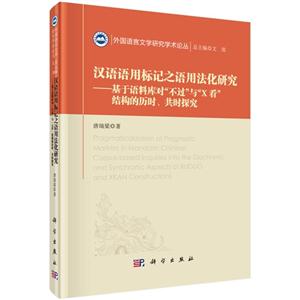汉语语用标记之语用法化研究-基于语料库对不过与X看结构的历时.共时探究
目录
contents丛书序i前言iiichapter one introduction11.1 rationale for the present research51.2 state of the art and problems91.2.1 previous researches on diachronic evolution of buguo and xkan91.2.2 previous researches on synchronic aspects of buguo and xkan131.2.3 why diachronic?161.2.4 interim summary221.3 diachronic work relevant to this book241.3.1 grammaticalization241.3.2 pragmaticalization311.3.3 models of semantic change361.4 data and methodology461.4.1 values of corpus-based research461.4.2 the data471.4.3 methodology for the analysis501.5 objectives of the present study521.6 outline of the book55chapter two pragmatic functions of buguo: a synchronic analysis572.1 data and methodology592.2 use and functional distribution of buguo in the corpus602.3 pragmatic functions of buguo632.3.1 metalinguistic functions632.3.2 metacommunicative functions722.4 the relationship between the core meaning of buguo and its pragmatic functions82chapter three pragmaticalization of buguo: a diachronic analysis873.1 data, distribution of buguo and methodology883.2 main meanings of guo913.3 historical development of buguo933.3.1 buguo in old chinese943.3.2 buguo in middle chinese1073.3.3 buguo in old mandarin1113.3.4 buguo in middle mandarin1193.4 pragmaticalization of buguo1243.5 motivations and mechanisms involved in the pragmaticalization of buguo1273.5.1 motivations for the pragmaticalization of buguo1273.5.2 mechanisms of the pragmaticalization of buguo1353.6 accompanying changes of the pragmaticalization of buguo1483.6.1 phonological changes1483.6.2 semantic changes1493.6.3 syntactic changes152chapter four pragmatic functions of xkan: a synchronic analysis1544.1 data and methodology1554.2 xkan: pm use vs. non-pm use1564.3 use and distribution of wokan and nikan in the corpus1604.4 pragmatic functions of wokan1644.4.1 self-quotation1644.4.2 wokan as a hesitation marker1704.5 pragmatic functions of nikan1744.5.1 nikan as an attention getter1764.5.2 nikan as a coherence builder1784.5.3 nikan as a politeness marker1824.5.4 nikan as a turn yielder1844.6 xkan as markers of interpersonal involvement1864.6.1 “involvement” in the present study1864.6.2 discussion188chapter five pragmaticalization of xkan: a diachronic analysis1905.1 distribution of wokan and nikan and methodology1915.2 core meanings of kan1925.3 historical development of xkan1945.3.1 historical development of wokan1945.3.2 historical development of nikan2065.4 pragmaticalization of xkan2185.5 motivations and mechanisms involved in the pragmaticalization of xkan2215.5.1 motivations for the pragmaticalization of xkan2215.5.2 mechanisms of the pragmaticalization of xkan2265.6 accompanying changes of the pragmaticalization of xkan2345.6.1 phonological changes2345.6.2 semantic changes2355.6.3 syntactic changes236chapter six historical development of buguo and xkan: cases of pragmaticalization2386.1 traditional interpretation of the rise of pragmatic markers2396.2 historical evidence from the evolution of buguo and xkan as pragmatic markers2446.2.1 grammar vs. pragmatics2446.2.2 discussion2496.3 pragmaticalization reconsidered2656.3.1 relationship between pragmaticalization and grammaticalization2656.3.2 a morpheme-based approach to pragmaticalization268chapter seven conclusion2707.1 review2707.2 directions for future study276references279appendix: a brief chronology of chinese history295 list of figuresfigure 1.1 evolution line of buguo in shen’s research10figure 1.2 model of the iitsc40figure 2.1 functional distribution of buguo82figure 3.1 buguo1 in the pre-qin period98figure 3.2 a sketch of the historical development of buguo125figure 3.3 functional change in buguo’s pragmaticalization126/272figure 3.4 general representation of the image schema of guo130figure 3.5 representation of the image schema of spatial guo130figure 3.6 representation of the image schema of temporal guo131figure 3.7 representation of the image schema of guo followed by abstract concept133figure 3.8 representation of the image schema of standard guo134figure 3.9 the iitsc model in the semantic shift of buguo’s pragmaticalization from buguo1 to buguo2140figure 3.10 semantic changes of buguo151figure 3.11 syntactic changes of buguo152figure 5.1 semantic-pragmatic functions of wokan in middle mandarin199figure 5.2 discursive behaviors of nikan in the southern song dynasty and the yuan dynasty211figure 5.3 functional change in wokan’s pragmaticalization219/273figure 5.4 functional change in nikan’s pragmaticalization220/273figure 5.5 semantic shifts of kan in xkan’s pragmaticalization222figure 5.6 invited inferencing in xkan’s pragmaticalization231figure 5.7 semantic changes of xkan235figure 5.8 syntactic changes of xkan236figure 6.1 pragmaticalization of buguo and unidirectionality262figure 6.2 pragmaticalization of xkan and unidirectionality263figure 6.3 clines of pragmaticalization266list
封面

书名:汉语语用标记之语用法化研究-基于语料库对不过与X看结构的历时.共时探究
作者:唐瑞梁
页数:296
定价:¥78.0
出版社:科学出版社
出版日期:2015-06-01
ISBN:9787030448347
PDF电子书大小:84MB 高清扫描完整版
